Crepe Myrtles
BackCrepe myrtles (Lagerstroemia spp) are a great addition to any garden, providing year round interest with attractive bark, spectacular flower displays and autumn coloured leaves. Native mainly to eastern Asia there are approximately 50 species of crepe myrtles.
The most popular in Australia is Lagerstroemia indica as it grows well in just about every climate zone. It produces clusters of ruffled flowers in summer and autumn that provide a long lasting display for months. Flower colours include white, pale pink through to reds and mauve/purple. In Autumn the leaves turn yellow, orange or red depending on the variety and then once they drop the striking trunk takes over the show with its smooth, mottled trunk in colours of brown, pink and grey.
Crepe myrtles grow into small trees 6-8m high with a natural vase-shape but there are some smaller growing varieties (see our suggestions at the bottom).
How to Grow Crepe Myrtles
Crepe myrtles are ridiculously easy to grow. Simply choose a sunny, well drained position and plant your tree. Water in with OCP eco-seaweed and apply some mulch to keep weeds away and help retain moisture. In heavy clay soils add gypsum to break up the clay and improve drainage. Trees perform best in rich fertile soil but will still grow in poorer quality soils.
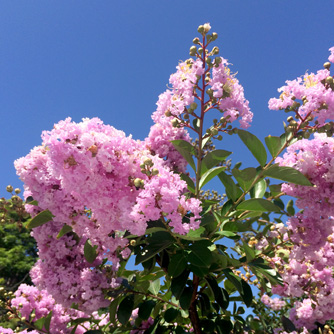
Beautiful pale pink crepe myrtle flowers
Crepe myrtles are frost tolerant but in areas with very hard frosts plant in a sheltered position. Young plants may need some protection until they develop hardened wood and some height about them.
They can withstand hot dry summers but will still appreciate some summer watering. Be sure to give extra water to new plants through their first summer to help them establish well. Crepe myrtles will also happily grow in the warm humid conditions of northern Australia.
Regardless of your climate choose a spot which has good air movement around the tree to reduce powdery mildew outbreaks.
Fertilising Crepe Myrtles
Established trees don’t need much more than a yearly feed of organic fertiliser, manure or compost in Spring. To encourage growth in young trees apply these fertilisers in Spring, Summer and Autumn. And for the gold star treatment water in OCP eco-aminogro and OCP eco-seaweed every 2-4 weeks right through the growing season.
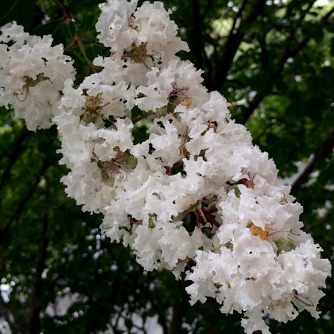
Stunning white crepe myrtle flowers
Maintenance & Pruning Crepe Myrtles
Crepe myrtles flower on the ends of new growth. Traditionally established trees have been pruned back hard in winter (a term known as pollarding). This encourages more new shoots in spring which will develop flower heads in summer. However, this does result in a harsh ‘stump’ and ruins the naturally beautiful shape of the tree. Crepe myrtles will still flower very well when left unpruned (flowers just tend to be higher up). If your intention is to grow your crepe myrtle as a tree then we recommend not pruning it.
For dwarf or smaller growing plants, trim the foliage back after flowering by about 20cm being careful to maintain a good shape.
As the tree matures, it’s a good idea to lift the canopy of the tree by pruning away any small, spindly growth lower down on the main trunks. This accentuates the lovely colours and patterns of the bark.
One downside with crepe myrtles is that they are prone to suckering. Once planted avoid digging around the base of the plant and damaging the roots. Suckers are more likely to shoot from the site of damaged roots.
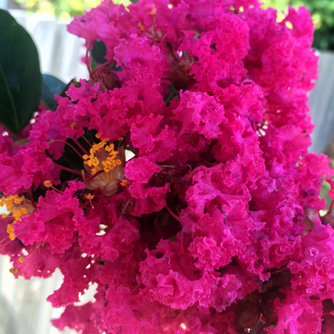
Other colours are available with crepe myrtles including deep pink
Pest and Disease Problems with Crepe Myrtles
Powdery mildew is a common problem especially with older varieties but can be controlled with an organic fungicide. Alternatively look for some of the new varieties and hybrids that are disease resistant like the Indian Summer range.
Our Favourites Crepe Myrtles
There are many shapes and sizes to choose from but here are a few tried and true varieties:
- Lagerstroemia indica Bayon ‘Marie’ – 1m x 1m with dark pink flowers, drought and heat tolerant
- Lagerstroemia indica x fauriei ‘Sioux’ – 4m x 3m with pink flowers, good powdery mildew resistance
- Lagerstroemia indica x fauriei ‘Lipan’ – 4m x 3m with lavender flowers, orange Autumn foliage
- Lagerstroemia indica x fauriei ‘Tuscarora’ – 6m x 4m with fuchsia pink flowers, red Autumn foliage
- Lagerstroemia indica x fauriei ‘Natchez’ –8m x 6m with white flowers, drought and heat tolerant
- Lagerstroemia indica ‘Yuma’ –8m x 6m with mauve flowers, drought and heat tolerant
If you are after something different search out the Australian native crepe myrtle (Lagerstroemia archeriana) which has pink mauve flowers and grows 7m plus high. Or look for the Diamonds in the Dark series which have dark burgundy/black foliage.
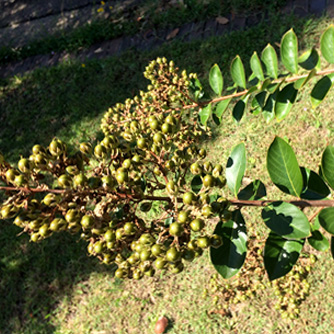
Prune off spent flower heads
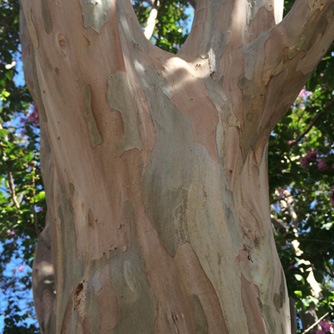
Crepe myrtles are also loved for their elegant patterned trunks
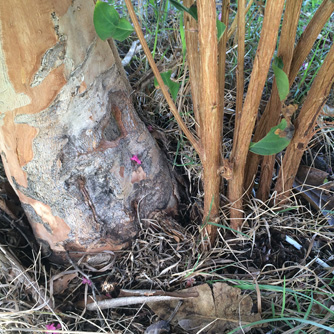
Crepe myrtle with suckers


